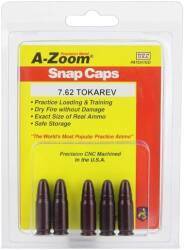
The Tula Tokarev or TT Pistol
The TT Pistol
Fyodor Tokarev designed a pistol in 1930 to replace the sidearm the Russian and then Soviet military had carried since the late 19th century introduction of the Nagant M1895 revolver. This new design became the TT-33 Tokarev pistol, which was widely used by Soviet troops throughout World War II. It fires the 7.62x25mm Tokarev cartridge, based on but slightly different from the German 7.63x25mm Mauser cartridge. It is still used by some police, militia, and security forces in Russia even through the 9x18mm Makarov PM pistol was adopted in 1952 and the Russian production of the TT-33 ended in 1954. As of 2014 the TT-33 was still in service as the official national sidearm in Bangladesh and North Korea, and many Pakistani police carry it unofficially.
The Russian Army had adopted the Nagant M1895 revolver in 1895, using a design by the Belgian gun designer Léon Nagant dating back to 1886. It had a seven-round cylinder, and a very unusual "gas-seal" design. Cocking the M1895 moves the cylinder forward to close the gap between the cylinder and barrel, increasing the muzzle velocity and providing the ability to suppress the weapon.
By the 1920s the Soviet Army was using the Nagant M1895 along with a variety of foreign produced revolvers and semiautomatic pistols.
The Soviet Revolutionary Military Council requested new designs in 1929. Fyodor Tokarev of the Design Bureau of the Tula Arms Plant had a design ready for testing early in January of 1931. Tokarev's design was quickly adopted as the TT-30 as in the Tula Tokarev design of 1930, and 1,000 pistols were ordered on 12 February 1931. It was officially known as the 7,62-мм Самозарядный Пистолет Токрева образца 1930 года, or 7,62-mm Samozaryadnyj Pistolet Tokareva obraztsa 1930 goda, the "7.62 mm Tokarev self-loading pistol model 1930."
A few thousand TT-30 pistols were manufactured in 1931 and 1932. A few updates were made in 1932 and 1933 to make the manufacturing process more efficient. Minor changes were made to the barrel, frame, trigger, and disconnector. Most prominently, the locking lugs on the barrel were changed to a full-circumference design. They are only needed on the top, to lock the barrel into the slide, but it was easier on a lathe to produce lugs fully encircling the barrel. Also, the removable backstrap was deleted. This new slightly modified design was officially accepted in early 1934 as the TT-33.
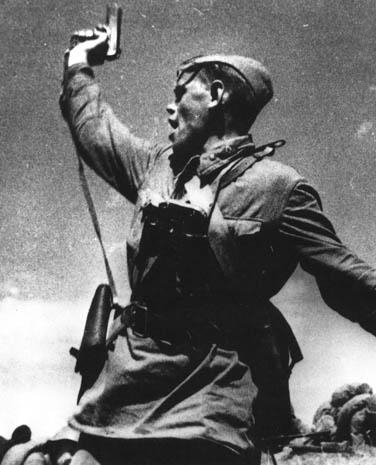
Here we see a junior officer of the Soviet Red Army with a Tokarev TT-33 during World War II, urging troops to advance toward German positions. The man is said to be political officer Алексей Гордеевич Еременко or Alexey Gordeevich Yeremenko, photographed just minutes before he was killed on 12 July 1942.
Tokarev's Design
Fyodor Vasilievich Tokarev or Фёдор Васильевич Токарев was born in a village in the Don Cossack region in 1871. He was admitted to the Military Vocational School in Novocherkassk in 1888, and began serving as a gunsmith in 1891 in the Don Cossack regiment in Radivlova-na-Volya. He then went on to graduate from Infantry Officers' School. In 1921 he went to work at the Tula Arms Plant. Among other honors for his service to the nation, he was awarded the Order of the Red Star, the Order of Lenin, made a Hero of Labor (1930), and a Hero of Socialist Labor (1940).
Tokarev's TT-33 design resembles John Browning's FN Model 1903 externally. Its internal operation uses a different prominent design of Browning's, the short-recoil dropping-barrel operation of the M1911.
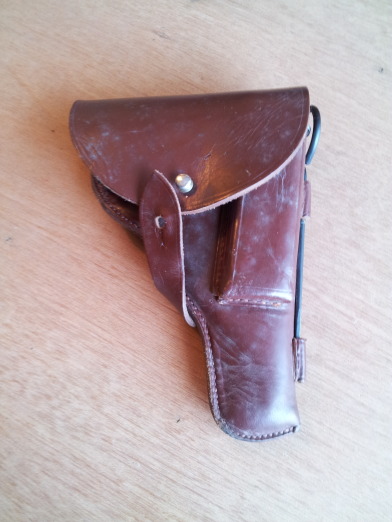
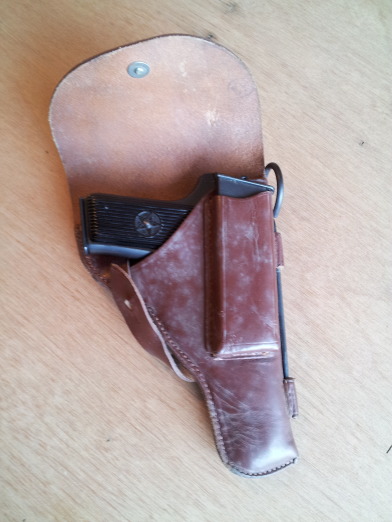
This TT pistol is in its holster along with a cleaning rod and a spare 8-round magazine.
The TT-33 is not entirely assembled from copies of Browning's design components. The hammer and sear assembly is much simpler than that of the M1911, and that assembly is easily removed from the frame as a self-contained module during field-stripping for cleaning and lubrication.
The TT pistol was designed for easy production and maintenance. In November and December of 1941, the equipment for manufacturing the TT-33 was moved further east and away from the German advances, to Izhevsk and the Machine-Building Plant #74. The wartime production was accelerated, with further slight simplifications to the design, lower quality machining (or at least rougher finishes), and wooden grip panels for some production runs. An experimental small run was produced with a staggered double-stack magazine with a capacity of 14 rounds, with the grip thickness increasing from 30.5 to 42 mm.
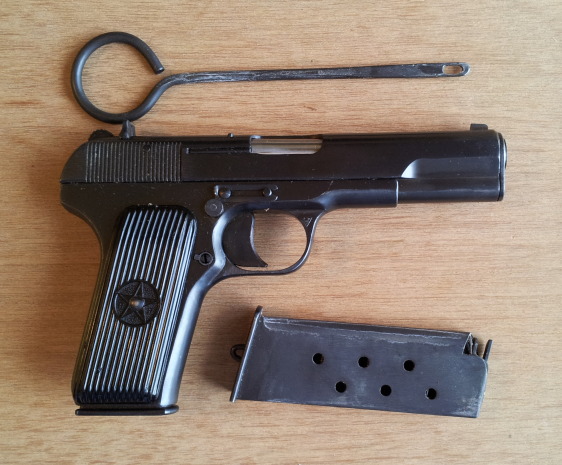
The Romanian TTC
A version of the TT-33 called the TTC for TT Cugir was manufactured at the Romanian State Arsenal or Regia Autonomă pentru producţia de Tehnică Militară (RATMIL), located in Cugir, in west-central Romania.
The Romanian TTC, like the original TT-33, does not have a trigger-blocking safety. It had a system using a half-cocked position of the hammer, in which the slide was locked and you had to either fully cock the hammer in preparation for firing, or fully cock it and carefully lower the hammer. The short and safe conclusion is the the TT pistol is not safe for carry with a round in the chamber.
To legally import them, a trigger-blocking safety had to be added. Below we see the required relabeling by the importer, in this case C.A.I. of the town of Georgia in Vermont. We also see the rather awkward safety added by the importer, just below the slide release lever. Many U.S. purchasers remove this added safety.
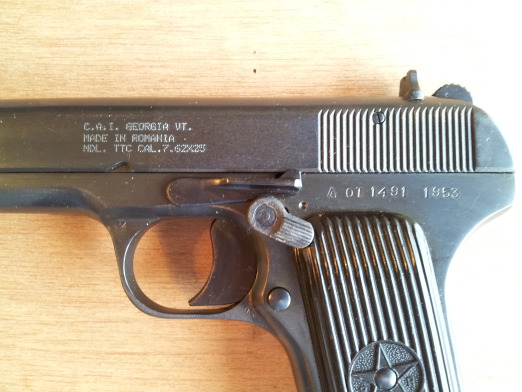
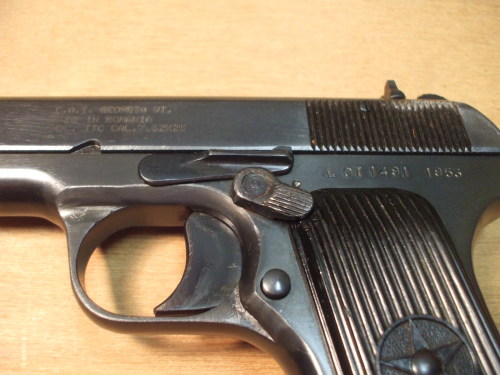
The shaft of the safety emerges from the other side, with its head further locking down the retaining clip for the slide release pin.
The magazine release is a button behind the trigger on the left side, much like that of the M1911. Unfortunately, the magazine release button is a little too easy to press, and if the magazine is slightly damaged it was all too common for the magazine to be released and fall out of the grip when drawing or even firing the weapon.
You can see the magazine release button in the two pictures above. Here on the left side you see the retaining screw for it.
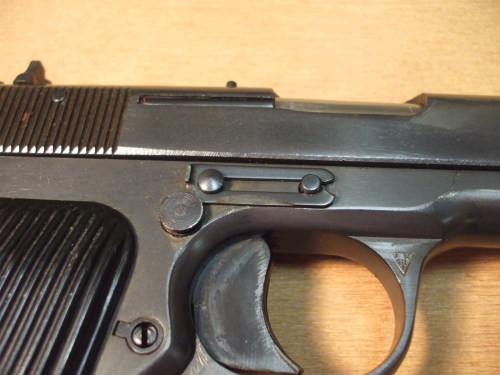
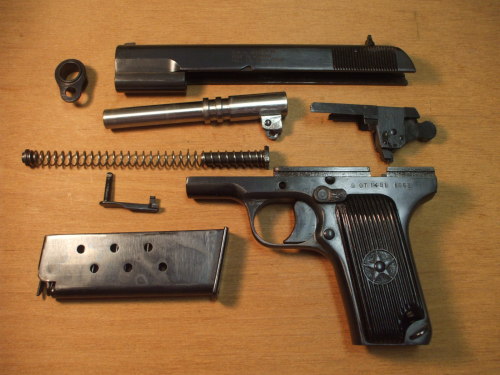
This TTC has been field stripped for cleaning. Notice the modular hammer and sear assembly.
Unlike the M1911, the return spring is attached to the follower.
You can also see the full-circumference locking lugs or really grooves around the barrel. Only the top section locks into the slide.
See the dedicated page for detailed directions on how to field strip the TT-33 / TTC pistol.
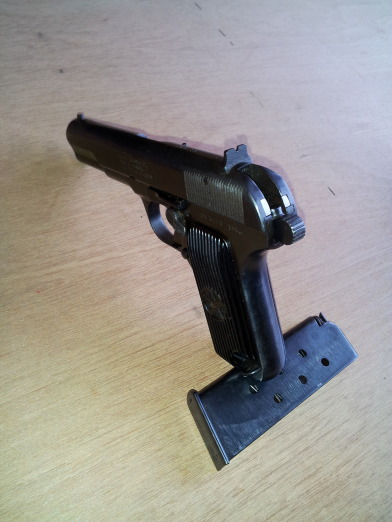
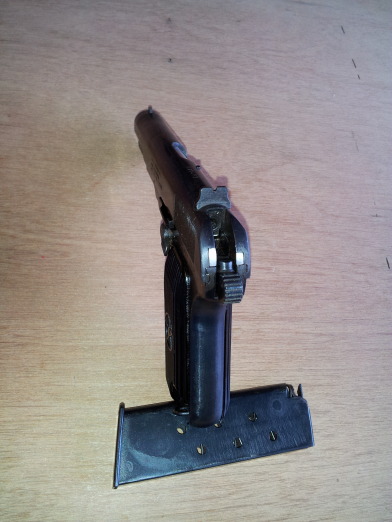

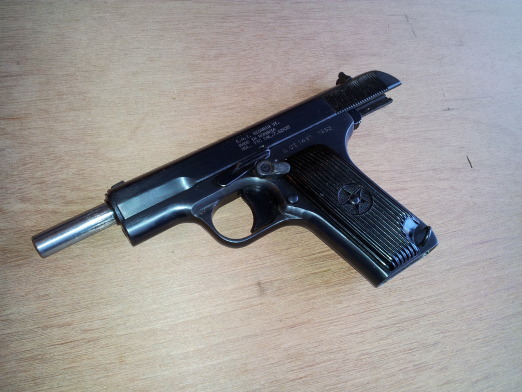
TT Redesigns and Variants
The TT pistol fires a very powerful cartridge providing high velocity and muzzle energy, with a flat trajectory and good accuracy.
It is relatively thin, making it quite concealable for a gun of this power and overall size.
This thin or flat design, however, coupled with the slightly too-vertical angle of the grip, leads to less than optimal ergonomics. The Hungarian arms manufacturer Fegyver- és Gépgyártó Részvénytársaság (or simply FÉG) manufactured an exact clone of the TT-33, and then in 1958 they came out with the TT-58 with a modernized and more ergonomic grip. FÉG had rebarreled it to fire 9x19mm Parabellum, calling it the M48, and manufactured an export version for the Egyptian police forces called the Tokagypt 58.
Norinco, the China North Industries Corporation owned by the People's Liberation Army, has made a variety of TT variants. These include the Type 51 and Type 54, military copies of the Soviet TT, and the Models 213, 213A, and 213V, firing 9x19mm Parabellum.
North Korea, Poland, and Yugoslavia made their own variants, several of them in the case of Yugoslavia.
